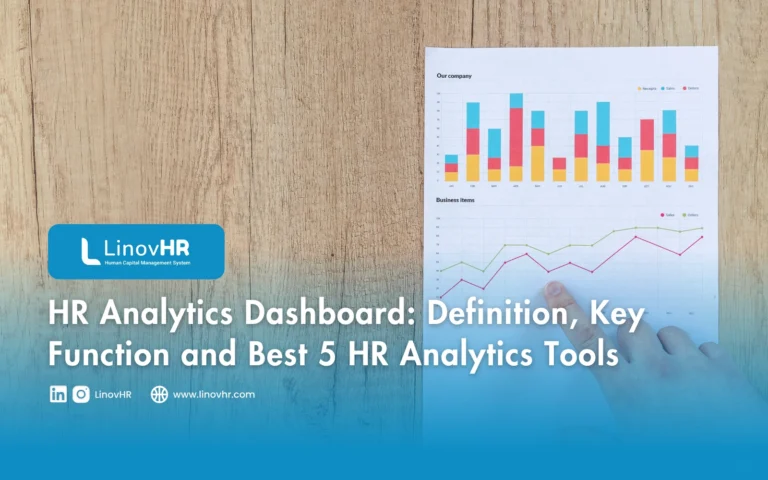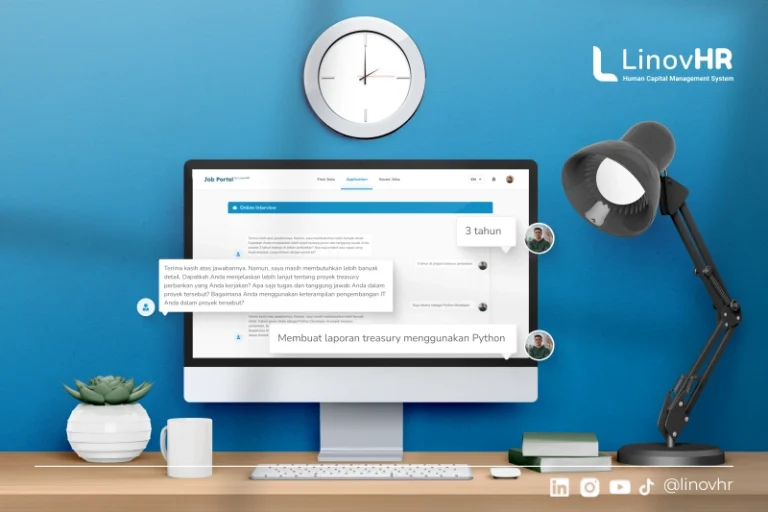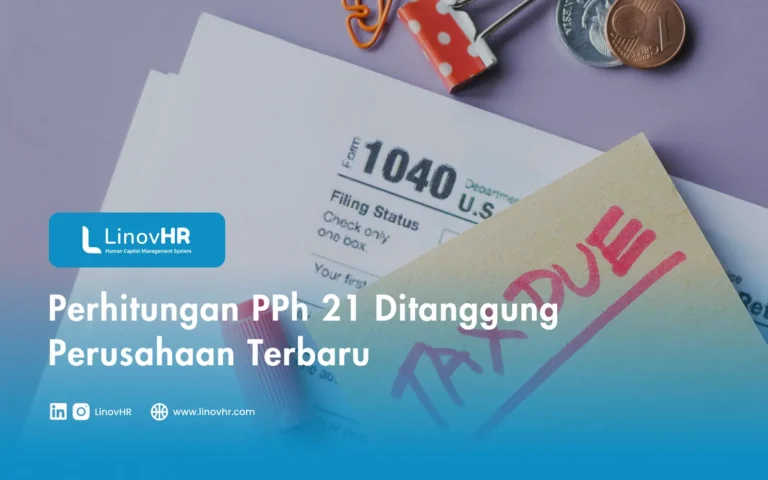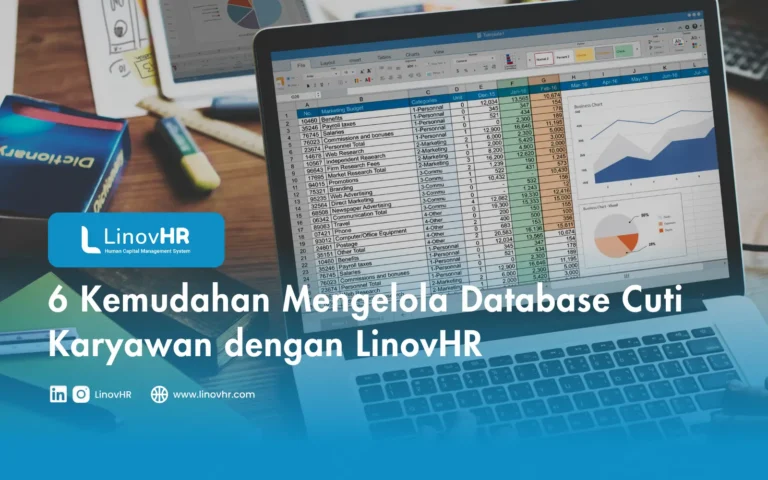In today’s fast paced business environment, data is one of the most valuable assets an organization can possess. For Human Resources (HR), the ability to gather, analyze, and interpret employee data has transformed how decisions are made.
HR departments are no longer focused solely on administrative tasks; they are now strategic partners contributing directly to business success through data-driven insights.
This evolution has given rise to the HR Analytics Dashboard, a powerful visualization tool that helps HR leaders monitor workforce metrics, identify trends, and make better-informed decisions.
By turning complex data into clear visuals, HR professionals can easily understand performance, engagement, and retention trends across the organization.
Ultimately, an effective HR data analytics dashboard empowers companies to align people strategies with overall business goals.
What Is an HR Analytics Dashboard?
An HR analytics dashboard is a data visualization platform that consolidates information from multiple HR systems such as payroll, recruitment, and performance management into one centralized view.
It allows HR professionals to track key metrics like turnover rates, absenteeism, and employee engagement in real time. By providing an at-a-glance summary of workforce performance, it helps leaders make strategic decisions backed by data rather than assumptions.
Modern organizations use HR analytics dashboard software to simplify data interpretation and identify actionable insights.
For instance, HR teams can analyze the correlation between employee satisfaction and productivity or assess which departments are experiencing high turnover rates. This kind of visibility enables proactive measures, improving employee retention and overall organizational efficiency.
The importance of an HR analytics dashboard in business goals beyond tracking numbers. It serves as a decision-support system that bridges HR and business performance.
With the growing demand for agility, dashboards help organizations anticipate talent shortages, plan training initiatives, and optimize workforce planning. Businesses that invest in these dashboards are better equipped to change quickly and make evidence-based HR decisions.
The importance of an HR analytics dashboard is not just a reporting tool it’s a strategic asset. It empowers HR leaders to visualize the health of their workforce, uncover patterns that impact productivity, and align HR goals with business objectives.
In an era where data-driven decision-making defines competitiveness, using analytics dashboards is essential for building a smarter, more responsive HR strategy.
Also Read: HR Analytics: Definition, Benefits, and How It Relates to HR Data Analytics
Key Functions of an HR Analytics Dashboard
Before investing in an HR Analytics Dashboard, it’s essential to understand its core function and how each contributes to smarter HR decision-making.
These functions go beyond reporting; they enable real-time insights, predictive forecasting, and strategic alignment between people and business goals.
1. Workforce Performance Monitoring
One of the main functions of an HR analytics dashboard is to monitor workforce performance. It allows HR teams and managers to track individual and team achievements against key performance indicators (KPIs) such as productivity, attendance, and goal completion rates.
By consolidating performance data from various HR systems, organizations gain a holistic view of employee efficiency and can identify both top performers and areas needing improvement.
Beyond surface-level tracking, this feature helps HR professionals detect performance trends across departments or job levels.
For instance, if one team consistently outperforms others, HR can analyze what drives their success and replicate those best practices company-wide. This continuous visibility enables proactive coaching, better performance appraisals, and more equitable reward systems.
2. Talent Retention and Engagement Insights
Employee retention and engagement are two of the most critical metrics for any HR department. An HR analytics dashboard provides actionable insights into factors that influence employee satisfaction such as workload, recognition, and development opportunities.
Through sentiment analysis and engagement data, HR can identify at-risk employees before they decide to leave.
For example, dashboards can reveal patterns like high turnover in specific teams or declining engagement scores after certain policy changes.
With this information, HR can design targeted interventions such as improving leadership communication or revising workload distribution. Over time, such proactive measures reduce turnover costs and strengthen employee loyalty.
3. Recruitment and Talent Acquisition Optimization
Recruitment analytics is another crucial function of an HR analytics dashboard software. By collecting data from applicant tracking systems (ATS) and other sources, HR can evaluate recruitment funnel efficiency from job postings to onboarding.
Dashboards can highlight which sourcing channels bring the highest-quality candidates or where delays occur in the hiring process.
Moreover, predictive analytics can forecast future hiring needs based on business growth or seasonal trends.
This allows HR teams to plan ahead, allocate resources effectively, and shorten time-to-hire. As a result, HR leaders can optimize recruitment strategies to attract better talent faster, ensuring the organization maintains a competitive edge.
4. Strategic Workforce Planning
An HR analytics dashboard plays a vital role in aligning HR strategies with business goals through workforce planning. It helps forecast talent demand, identify skill gaps, and analyze labor costs.
HR leaders can simulate different scenarios such as organizational restructuring or rapid expansion to understand potential workforce implications.
With a visual dashboard, executives can easily see whether the current workforce composition supports long-term business objectives.
This enables HR to collaborate more effectively with top management in shaping strategic plans. Over time, data-driven workforce planning ensures organizations are not just reacting to changes but anticipating them with confidence.
5. Compliance and Data Accuracy
Another critical function of an HR analytics dashboard software is ensuring compliance with labor laws and internal policies.
By automating data tracking and reporting, HR dashboards reduce human error and ensure information accuracy. Many systems also include audit trails and access controls to safeguard sensitive employee data.
Maintaining compliance not only prevents legal risks but also trust among employees. With reliable and transparent data, HR professionals can confidently present metrics to executives, regulators, or auditors, strengthening organizational integrity and accountability.
HR Analytics Dashboard Examples
Before implementing an HR analytics dashboard, it’s helpful to understand how organizations actually use them in practice.
The best HR analytics examples showcase how data visualization and insights can improve workforce management, retention, and overall business performance.
Below are several common types of HR data analytics dashboards that demonstrate how analytics transform raw HR data into actionable strategies.
1. Employee Performance Dashboard
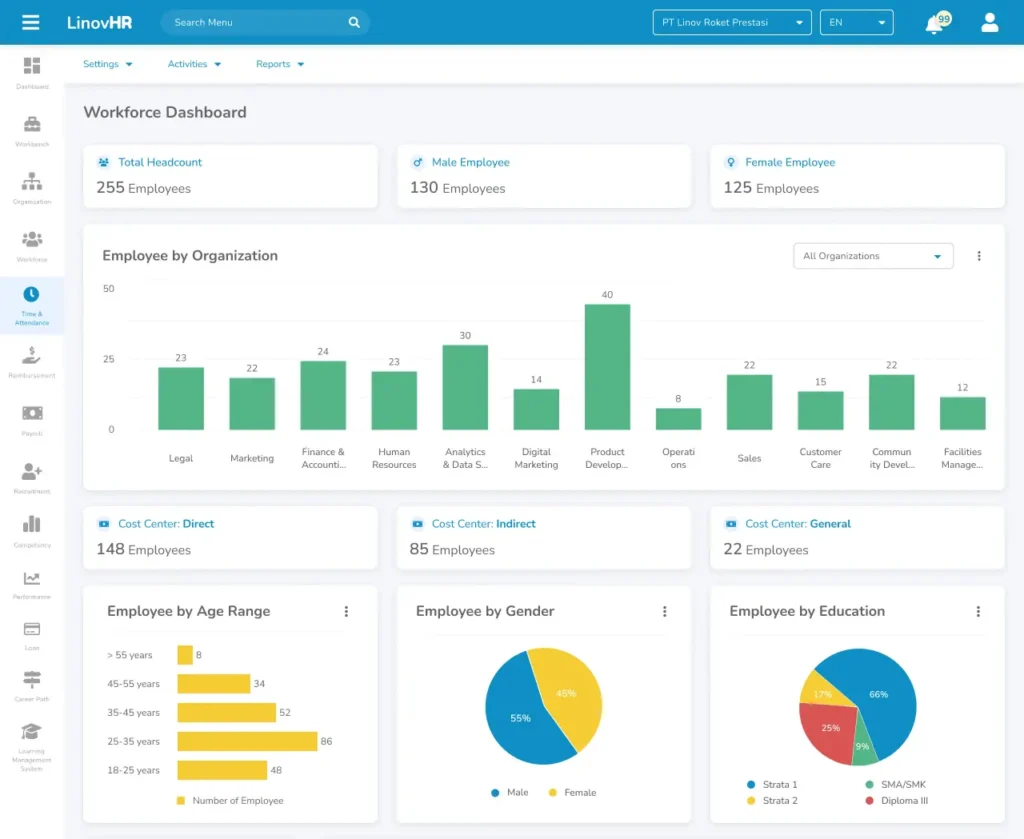
An employee performance dashboard allows HR professionals to track how employees perform individually and collectively.
This type of HR analytics dashboard visualizes metrics such as productivity scores, project completion rates, performance ratings, and goal progress.
By consolidating performance data in one place, HR teams can identify high performers and provide targeted development for underperforming employees.
Managers can also use these dashboards to assess performance distribution across departments and understand what drives success in top teams.
Furthermore, combining this dashboard with predictive analytics helps HR forecast which employees are most likely to excel or require support.
This insight enables proactive coaching and fair, data-driven performance evaluations, enhancing both motivation and transparency across the organization.
2. Recruitment and Hiring Dashboard
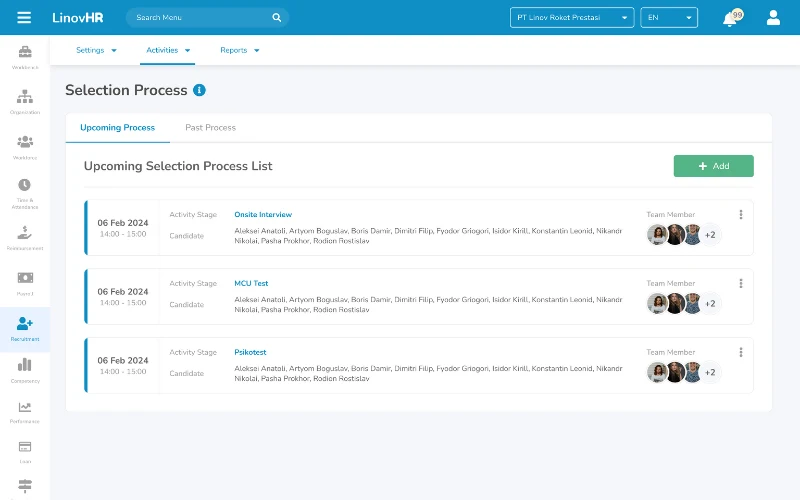
A recruitment analytics dashboard focuses on optimizing the hiring process. It tracks metrics such as time-to-hire, cost-per-hire, applicant source effectiveness, and candidate quality.
By centralizing data from job boards, career sites, and applicant tracking systems (ATS), this HR analytics dashboard software helps HR professionals see which recruitment channels deliver the best results.
For instance, HR can identify if referrals bring higher-performing candidates or if certain stages in the hiring funnel cause unnecessary delays.
Over time, these insights lead to more efficient recruitment strategies and better resources allocation.
Additionally, the dashboard can forecast upcoming hiring needs based on business growth trends. With this information, HR leaders can plan workforce expansion strategically rather than reactively helping organizations stay ahead in the war for talent.
3. Employee Engagement Dashboard
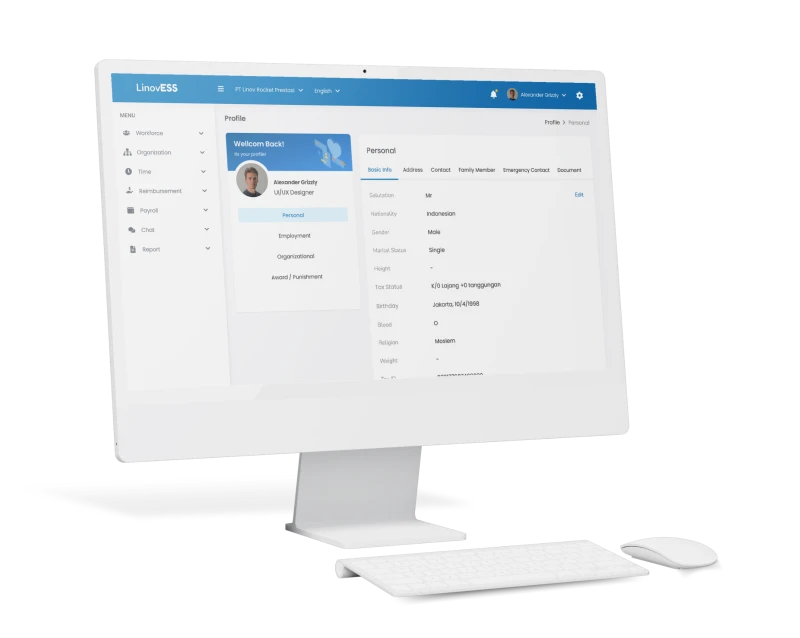
(Sumber: linovhr.com)
The employee engagement dashboard measures employee satisfaction, motivation, and overall workplace sentiment. It compiles data from surveys, pulse checks, and performance feedback to visualize engagement over time.
This type of HR analytics example helps organizations detect early signs of disengagement, such as declining survey scores or increased absenteeism.
HR leaders can then take targeted actions like revising communication strategies or enhancing recognition programs to improve morale and reduce turnover.
In addition, this dashboard provides executives with insights into which departments are thriving and which may require cultural or leadership adjustments.
A strong engagement dashboard empowers organizations to maintain a healthy, motivated workforce that directly contributes to productivity and innovation.
4. Diversity, Equity, and Inclusion (DEI) Dashboard

A DEI analytics dashboard is increasingly vital in modern organizations. It tracks key diversity indicators such as gender ratio, pay equity, age distribution, and representation across management levels.
By visualizing these metrics, HR professionals can evaluate how inclusive their workforce truly is and identify areas for improvement.
For example, HR can use this dashboard to monitor whether promotions and compensation sign fairly across genders or minority groups. This data-driven transparency helps create a culture of equity and accountability.
Furthermore, linking DEI data with performance and engagement metrics can reveal powerful insights such as how diverse teams perform better in innovation and decision-making. With continuous monitoring, organizations can build stronger, fairer, and more inclusive workplaces.
5. Workforce Turnover Dashboard
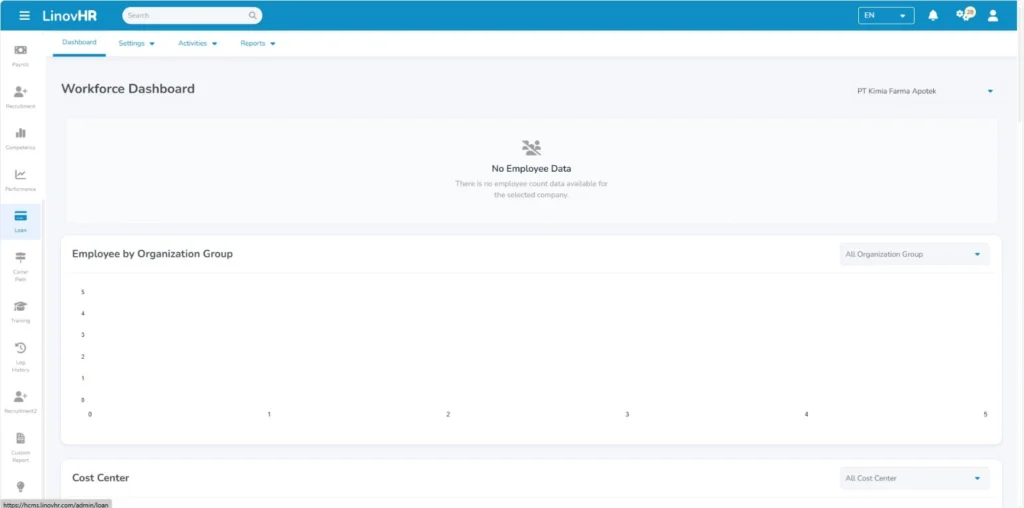
The turnover analytics dashboard helps HR track employee exits, retention rates, and turnover causes. It’s one of the most critical types of HR data analytics dashboard, as turnover directly affects costs, morale, and productivity.
By analyzing turnover by department, tenure, or job level, HR professionals can detect problematic patterns, such as high exits in specific teams or after certain policy changes.
Predictive models can even identify which employees are most likely to leave in the near future, giving HR time to intervene before it’s too late.
This proactive approach allows organizations to address retention challenges early, improve employee satisfaction, and reduce recruitment costs.
Over time, turnover dashboards become indispensable tools for maintaining organizational stability and continuous growth.
Best 5 HR Analytics Dashboard Software
Choosing the right HR analytics dashboard software is essential for turning complex HR data into actionable business insights.
The best tools offer customizable dashboards, automation features, and predictive analytics that empower HR teams to make smarter, data-driven decisions.
Below are five of the best HR analytics dashboard software you should explore, each designed to help HR professionals monitor performance, engagement, and workforce trends efficiently.
Also Read: Top 10 HR Analytics Tools Every HR Professional Should Know
1. LinovHR

LinovHR provides a comprehensive HR analytics dashboard that centralizes all workforce data into a single, visually intuitive platform.
From recruitment to attendance and performance evaluation, LinovHR helps HR professionals track trends and measure organizational health in real time.
Its dynamic dashboards present essential HR metrics such as employee turnover, absenteeism, and productivity through clear, customizable visualizations.
HR leaders can also segment data by department or time period, making it easier to identify problem areas and take targeted action.
With predictive analytics and automated reporting, LinovHR helps organizations move beyond static data to proactive decision-making.
Its integration across multiple HR modules provides a seamless analytics experience for companies looking to optimize efficiency and employee engagement.
| Pros | Cons |
| User-friendly dashboard interface | Limited third-party integrations |
| Strong visualization & KPI customization | Advanced analytics require initial setup |
| Predictive and real-time insights | Available primarily in certain regions |
| Seamless integration with LinovHR modules | |
| Excellent customer support | |
| Affordable for its features range | |
| Customizable to fit company size |
2. BambooHR
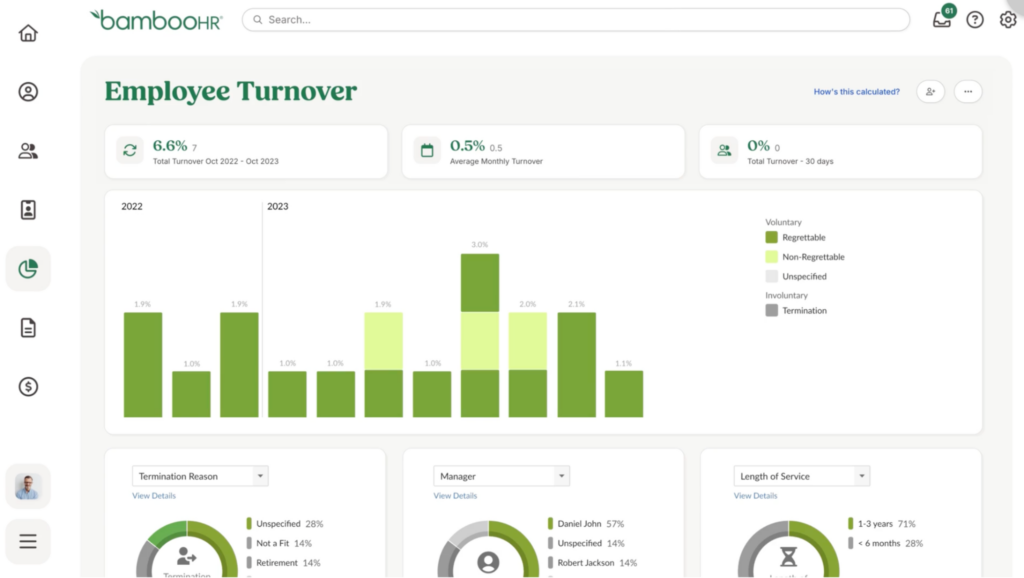
BambooHR offers one of the most intuitive HR analytics dashboards for small to medium-sized businesses. Its dashboard provides a clear overview of workforce data, from employee performance and time-off tracking to retention and engagement metrics.
The platform’s simplicity is its biggest strength; users can easily generate reports, analyze turnover trends, and gain actionable insights without technical expertise.
Its real-time analytics feature enables HR professionals to make informed decisions quickly, especially when managing team growth and productivity.
In addition to analytics, BambooHR integrates seamlessly with payroll and performance modules, giving HR teams a holistic view of employee data.
This makes it an ideal solution for organizations seeking a balance between usability and functionality.
| Pros | Cons |
| Simple and intuitive interface | Limited customization options |
| Great for SMBs | Basic analytics compared to enterprise tools |
| Strong integration with HR functions | Lacks predictive analysis features |
3. Rippling
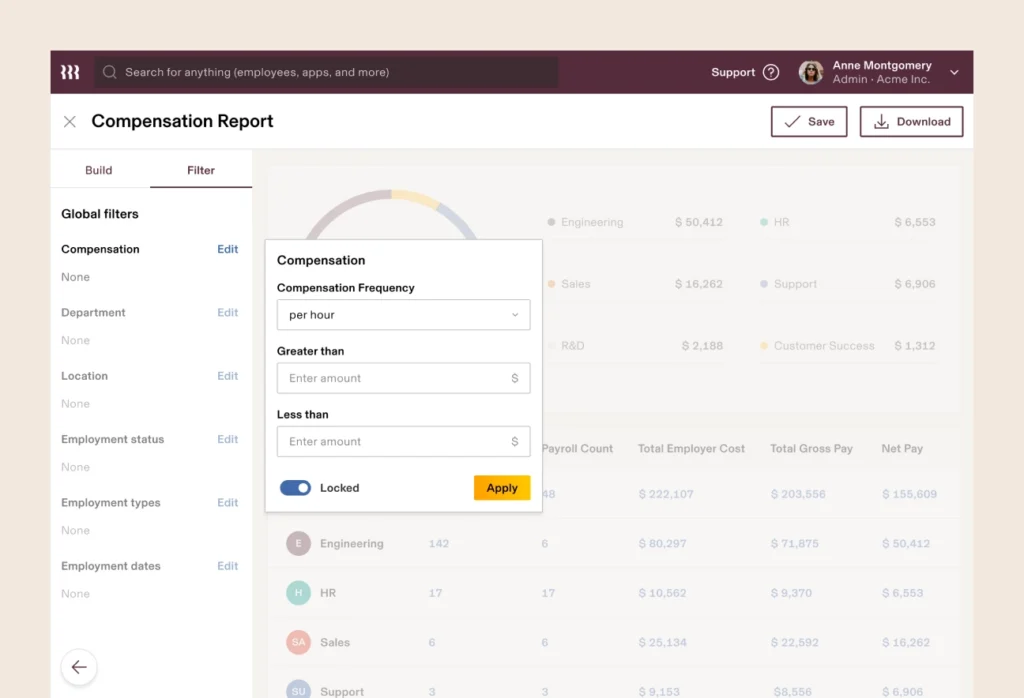
Rippling is a powerful all-in-one workforce platform that combines HR, IT, and finance analytics into a single unified dashboard. Its HR analytics dashboard helps leaders monitor employee trends, compensation data, and compliance metrics effortlessly.
The dashboard is designed for real-time visibility, giving HR professionals access to data from multiple systems like payroll, performance management, and benefits administration.
With customizable reports and visualizations, Rippling allows companies to drill deep into workforce analytics with minimal setup effort.
Moreover, Rippling’s automation capabilities make it possible to synchronize data across departments instantly, reducing manual data entry errors. This automation ensures HR teams always work with accurate, up-to-date information when making strategic decisions.
| Pros | Cons |
| Unifies dashboard across HR, IT, finance | Higher price for small businesses |
| Excellent automation & integration | Some features require add-on module |
| Real-time analytics with minimal setup | Limited offline access |
4. Visier

Visier is a top-tier people analytics platform tailored for enterprise-level organizations that require deep workforce insights. Its pre-built HR dashboard covers a wide range of areas such as diversity and inclusion, retention, performance, and working planning. This helps HR leaders make informed, evidence-based decisions with confidence.
Visier stands out for its advanced predictive analytics, which forecast turnover risks and identify key factors influencing employee performance.
HR teams can leverage these insights to implement targeted interventions that improve engagement and productivity.
The platform also supports benchmarking capabilities, allowing companies to compare their workforce metrics with industry standards.
Visier’s focus on scalability and strategic insights makes it one of the most powerful HR analytics solutions for large organizations seeking to optimize their people strategy.
| Pros | Cons |
| Strong predictive and perspective analytics | High cost for small businesses |
| Enterprise-grade HR insights | Implementation can take time |
| Great for strategic workforce planning | May be too advanced for basic HR analytics |
5. Softr
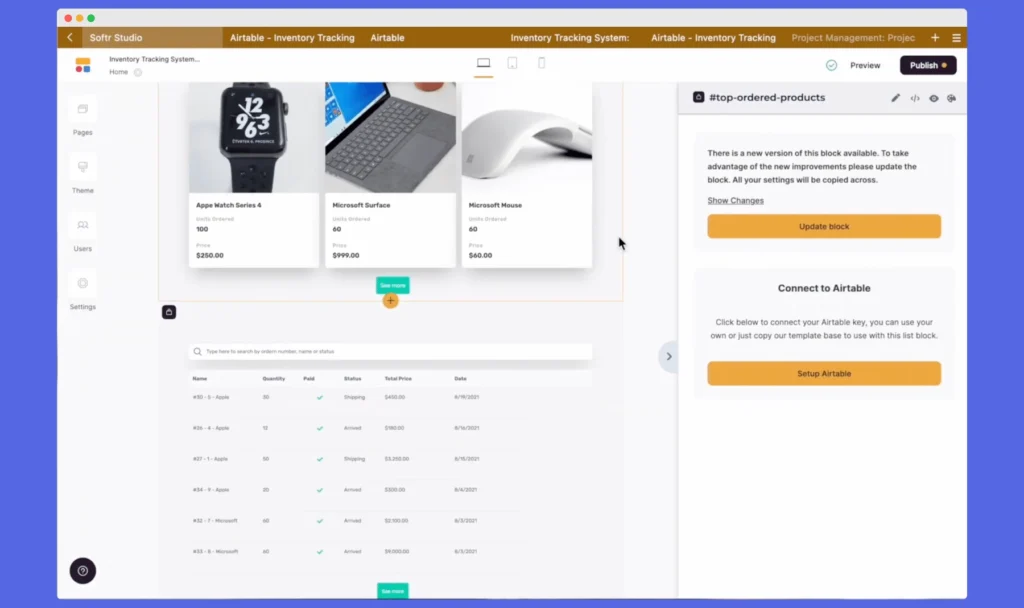
Softr is a no-code platform that enables HR teams to build fully customized HR analytics dashboard without programming.
By connecting with data sources like Airtable, Google Sheets, or Excel, HR professionals can visualize workforce data in an interactive and dynamic way.
This flexibility allows HR departments to create dashboards for attendance tracking, performance monitoring, or employee engagement within minutes.
Softr’s pre-designed templates make it easy for HR professionals to get started even without prior technical knowledge.
Its greatest advantage lies in adaptability, Softr empowers HR teams to design dashboards that fit their unique workflows and KPIs.
The platform is particularly valuable for growing organizations that want to experiment with data visualization before investing in more advanced enterprise solutions.
| Pros | Cons |
| No-code platform, easy to use | Limited for complex analytics |
| Flexible and customizable templates | Depends on external data sources |
| Great for SMBs and startups | Lacks predictive capabilities |
Optimize HR Decisions with LinovHR Analytics Dashboard
In today’s data-driven business landscape, HR analytics dashboards have become essential for organizations aiming to make smarter, faster, and more strategic decisions.
Having access to real-time workforce insights allows HR leaders to understand performance trends, employee engagement, and operational efficiency, all in one place.
With LinovHR’s analytics dashboard, companies can move beyond traditional HR reporting. This powerful solution transforms complex data into clear visual insights, enabling HR teams to track KPIs, monitor workforce dynamics, and make informed decisions that align with business goals.
LinovHR dashboard provides flexibility, accuracy, and depth all integrated within its complete HRIS ecosystem. Whether you’re optimizing recruitment, evaluating performance, or managing turnover, LinovHR helps you see the bigger picture behind your people’s data.
Make data-driven HR decisions that drive success, request a free demo today!


